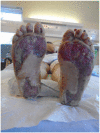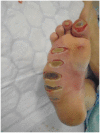Limitations to the use of bromelain-based enzymatic debridement (NexoBrid®) for treating diabetic foot burns: a case series of disappointing results
- PMID: 30574406
- PMCID: PMC6295758
- DOI: 10.1177/2059513118816534
Limitations to the use of bromelain-based enzymatic debridement (NexoBrid®) for treating diabetic foot burns: a case series of disappointing results
Abstract
Background: Bromelain-based enzymatic debridement with Nexobrid® (Mediwound) is an alternative to traditional surgical tangential excision of deep dermal and full thickness burns. Early literature suggests that Nexobrid debridement could reduce the number of operations, infection rates, inpatient stay and the necessity for skin grafting to wounds by preserving viable tissue. To our knowledge there are no previous studies reporting the use of NexoBrid for treating burns in patients with established diabetic foot disease.
Case presentation: We conducted a retrospective case series and identified four patients with diabetic foot burns that were treated with Nexobrid® debridement. All of these patients developed further eschar and deepening of their wounds a few days after NexoBrid was applied, requiring further surgery and skin grafting.
Conclusions: We would recommend judicious use of this new product in patients with diabetic foot wounds.
Keywords: Enzymatic debridement; NexoBrid; bromelain; burns; contact; diabetic; foot.
Conflict of interest statement
Declaration of conflicting interests: The authors declared no potential conflicts of interest with respect to the research, authorship, and/or publication of this article.
Figures











References
-
- Edmondson S-J, Ali Jumabhoy I, Murray A. Time to start putting down the knife: A systematic review of burns excision tools of randomised and non-randomised trials. Burns 2018; 44: 1721–1737. - PubMed
-
- Hirche C, Citterio A, Hoeksema H, et al. Eschar removal by bromelain based enzymatic debridement (Nexobrid ® ) in burns: An European consensus. Burns 2017; 43(8): 1640–1653. - PubMed
-
- Schulz A, Fuchs PC, Rothermundt I, et al. Enzymatic debridement of deeply burned faces: Healing and early scarring based on tissue preservation compared to traditional surgical debridement. Burns 2017; 43(6): 1233–1243. - PubMed
-
- Schulz A, Perbix W, Shoham Y, et al. Our initial learning curve in the enzymatic debridement of severely burned hands—Management and pit falls of initial treatments and our development of a post debridement wound treatment algorithm. Burns 2017; 43(2): 326–336. - PubMed
-
- Noor S, Zubair M, Ahmad J. Diabetic foot ulcer—A review on pathophysiology, classification and microbial etiology. Diabetes Metab Syndr Clin Res Rev 2015; 9(3): 192–199. - PubMed
How to cite this article
Publication types
LinkOut - more resources
Full Text Sources

